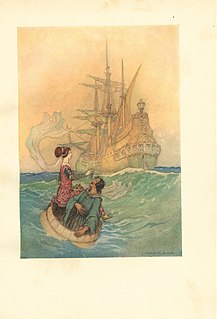Drakestail also known as Quackling is a French Fairy tale about a duck, where repetition forms most of the logic behind the plot. The story is also similar to other folk and fairy tales where the hero picks up several allies and uses them in the exact order found.
The Mermaid and the Boy is a Sámi fairy tale collected by Josef Calasanz Poestion in Lapplandische Märchen. Andrew Lang included an English-language version in The Brown Fairy Book (1904).
"Ferdinand the Faithful and Ferdinand the Unfaithful" is a German fairy tale collected by the Brothers Grimm, tale number 126.
The Dolphin is a French literary fairy tale by Madame d'Aulnoy.
The Firebird and Princess Vasilisa is a Russian fairy tale collected by Alexander Afanasyev in Narodnye russkie skazki. It is one of many tales written about the mythical Firebird.
French folklore encompasses the fables, folklore, fairy tales and legends of the French people.
"The Griffin" is a German fairy tale collected by the Brothers Grimm in Grimm's Fairy Tales.

Peruonto is an Italian literary fairy tale written by Giambattista Basile in his 1634 work, the Pentamerone.
"Corvetto" is an Italian literary fairy tale written by Giambattista Basile in his 1634 work, the "Pentamerone".
The Three May Peaches is a French fairy tale collected by Paul Delarue. He collected more than thirty French types of this tale, which is known in Europe, North Africa, and Asia as far as India.
Jean, the Soldier, and Eulalie, the Devil's Daughter is a French fairy tale collected by Achille Millien.
"King Fortunatus's Golden Wig" is a French fairy tale collected by Colonel A. Troude and G. Milin in Le Conteur breton ou Contes bretons.
Father Roquelaure is a French fairy tale collected by Achille Millien.
The Raven is an Italian literary fairy tale written by Giambattista Basile in his 1634 work, the Pentamerone. The story is a man winning a bride for his brother the king, and then having to protect the couple from perils that he can not tell anyone about, without being turned to stone.
La Ramée and the Phantom is a French fairy tale collected by Achille Millien and Paul Delarue.
Little Johnny Sheep-Dung is a French fairy tale collected by Achille Millien and Paul Delarue.
The White Dove is a French fairy tale collected by Gaston Maugard in Contes des Pyrénées.
The Lost Children is a French fairy tale collected by Antoinette Bon in Revue des traditions populaires.
Georgic and Merlin is a French fairy tale collected by François Cadic in "La Paroisse bretonne".
The Princess in the Chest, also known as The Princess in the Coffin is a Danish fairy tale. Andrew Lang included it in The Pink Fairy Book.
